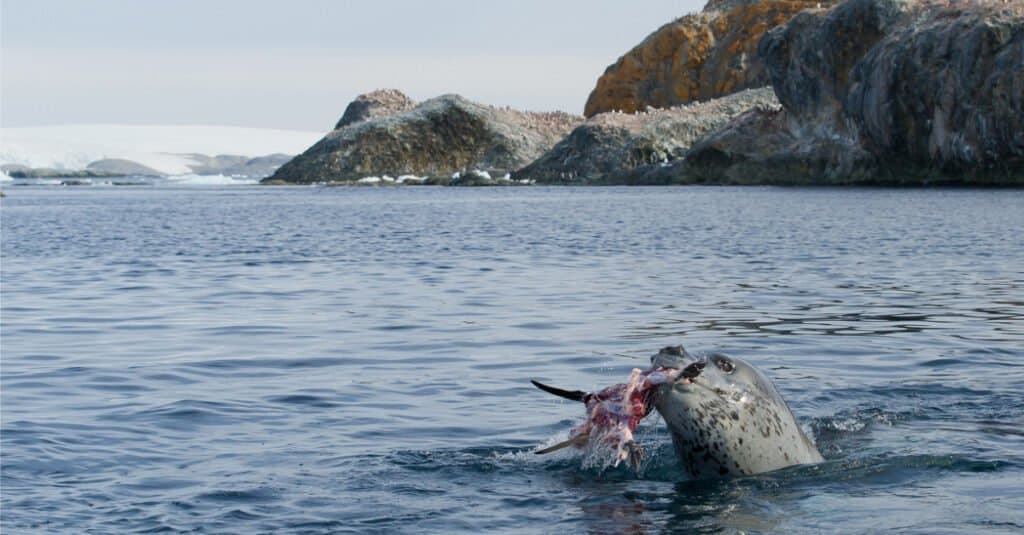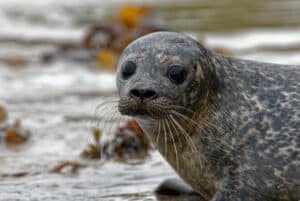Seals are generally affable semi-aquatic mammals. They are often sheltered in zoos and marine life attractions because they can be trained like dolphins. Are seals friendly? They seem to be curious if not friendly. Seals are also look cute and cuddly, like dogs of the ocean. It would certainly be tempting to hold and caress one when you see them in the wild. Generally, seals are not poisonous or dangerous to humans, so there is no reason to worry about seals attacking you and hurting you out of nowhere. However, behind their sweet and cuddly facade, you still can’t touch or feed them in the wild because they may bite. While seal attacks on humans are rare, as seals are naturally not aggressive animals, they can still bite in defense when they feel cornered or provoked. Seal bites are mostly non-fatal to humans but can cause serious infections. While most seal species are not aggressive against humans, there is one specific seal species you should watch out for – the leopard seal. The leopard seal has a record of being aggressive towards humans and one count of a fatal encounter.
Do Seals Bite?

Seals can bite, but usually as an act of self-defense.
©Tarpan/Shutterstock.com
All animals equipped with teeth, beaks, or pincers can “bite” humans and other animals when they feel threatened or provoked, and so do seals. Most seals are not known to be aggressive. Seal attacks on humans are rare, but they have happened. Seals, especially in their natural habitat, are often timid and would not initiate an attack out of anywhere. Yet, when they feel threatened or provoked, they can bite as an act of self-defense.
Seals appear to be appealing and friendly, which they are indeed. Most zoos and marine attractions showcase seals as trainable, intelligent, and friendly to humans. They can be taught to perform shows and provide entertainment to humans. However, seals in the wild may not be as interactive as the seals we know in zoos and aquaria. Are seals friendly to humans in their natural habitats? Probably not, but even if they seem to be – keep your distance. In the wild, human contact with seals does more harm than good.
As seals are still considered wild animals, they can be stressed from human attention and feel uncomfortable or threatened. Once these marine mammals feel threatened, they can lash out and bite as a warning for you to back off. Because seals are not aggressive, their bites would often serve as a threat or warning and would rarely intend to hurt or injure you. Seal bites are not fatal or gravely dangerous either, but they can cause infections.
Are Seals Dangerous to Humans?

Seals are not dangerous to humans as they rarely initiate attacks.
©Sergey Uryadnikov/Shutterstock.com
Generally, seals will not initiate an attack against humans on purpose and out of nowhere. Although there have been a few reports of seal attacks, it is quite rare. Seals are not dangerous, and even though they may bite, they cannot be fatal as they are not venomous and do not contain rabies. It is unusual for a seal to contract rabies even though they are mammals because rabies is more common for land mammals. Yet, seal bites can transmit infections, specifically the infamous ‘seal finger,’ a common seal bite effect.
Seals may be aquatic, but they are mammals like us, which means they can transmit viruses and bacteria like herpes when they bite. Zoonosis, an infection that animals can pass on to humans, is one of the most significant risks you face when bitten by a seal. Though seals rarely contract rabies, their bites can include bacteria, fungi, and other parasites transmitted to humans. Even though seal bites are not entirely harmful or fatal, they still need to be attended to medically.
Seal finger, for instance, is a known infection that affects most seal hunters or seal handlers resulting from seal bites. Also known as sealer’s finger, it can also be caused by exposure to untreated seal fur. Despite the name, the seal finger refers to the infection of any part of the body resulting from a seal’s bite. Most of the time, when seals bite, the bacteria from their bite will travel through the blood and across the body, affecting the fingers and making them swell. Yet, a seal finger can refer to the infection of any body part as long as the bite causes it. For instance, a seal bite on the leg can cause an infection of the right hand. Apart from seal bites, a seal finger can also be contracted upon exposure of an open wound to seal blood or seal saliva.
Seal finger can be treated, but it can cause severe swelling, pain, and joint damage. Some antibiotics are also no use against seal finger. A seal finger infection can hinder people from using their hands if left untreated.
Are Leopard Seals Dangerous?

Leopard seals are aggressive and brutal when it comes to hunting their prey.
©iStock.com/mzphoto11
Though most seals can only pose a risk of infections and nothing more, one species of seal is way more aggressive than the others and has even been reported to cause a fatality. This seal is the leopard seal. Leopard seals are best left in the wild, as they have sharper teeth than most seal species. They are also known to be aggressive and brutal in hunting their prey, so they are more feared than other seals.
Leopard seals will only attack when they feel provoked or threatened, but like with any other animal, there are some exempted scenarios. In 2003, a leopard seal killed a marine biologist and drowned her almost 60 feet or 200 meters deep. While the reason remains unclear, it is still a reminder to be cautious when meeting wild animals.
How to Avoid Seal Bites
The increasing proximity between people and seals in the wild is causing more seal bite incidents. As seals continue to habituate to humans, they are more likely to feel less afraid of humans. For instance, humans feeding seals can encourage them to approach boats or ports waiting for handouts. This has resulted in many incidents of seal injuries on boat propellers. Hence, humans should keep their distance from these wild animals.
The photo featured at the top of this post is © Mogens Trolle/Shutterstock.com
Thank you for reading! Have some feedback for us? Contact the AZ Animals editorial team.






